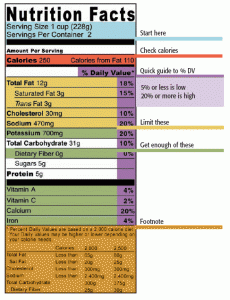Nutrition labels are extremely useful when trying to determine what one should buy at the store. However, many Americans don’t utilize these. The Journal of the American Dietetic Association tracked 203 people as they looked at grocery items. According to the tracker, which looked at eye movements, only about 9 percent actually looked at the calorie information, while only 1 percent looked at the other information. This is extremely distressing, as food labels can really make a difference when it comes to choosing healthier options. [1]
[1]
While food labels might look complicated to those who have never used them, they are in fact extremely simple once you know what to look for. Here’s a simple breakdown of what you should be looking for:
Serving Size:
The serving size is always at the top of the label. It is very important to see just how much a serving is, as many people eat three times the suggested serving without even realizing it. The servings per container are also useful in knowing just how many servings are in the package. In the above label, a serving size is a cup, and you would consume two cups if you ate the whole thing. Once you know how much a serving is, you can then look at the rest of the label.
Calories:
Calories determine how much energy you will gain from eating whatever the food is. Low calories don’t necessarily mean the food is healthy, same as high calories don’t mean it’s necessarily bad for you. It’s important to look at the rest of the information to determine how nutritious it is.
Fat, Cholesterol, and Sodium
Generally, lower is better for these. Saturated and Trans fat are the bad fats, so the lower the better. Trans fat is especially bad for you, so try to stay away from these completely. Cholesterol is a major factor in heart disease, so too much is a bad thing. Also, Americans consume way too much sodium, so finding foods lower in sodium is key.
Fiber
An important key in eating healthy is fiber. Foods rich in fiber keep you feeling fuller longer, which means you’ll eat less and still feel satisfied. Fiber can also play a role in regulating digestion.
It’s also a good idea to check the ingredients to see what exactly you’re putting into your body. Beware of foods that contain processed ingredients. A general rule of thumb is the simpler the ingredients, the better.
Understanding these will help you make healthier decisions when it comes to deciding what foods to eat. While these aren’t the only items on the food label, they are a good start to understanding just what it is you should be eating.
Do you read all of your food labels?
Assistance Provided by Tori Thompson [2]
